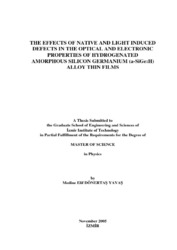Please use this identifier to cite or link to this item:
https://hdl.handle.net/11147/3188| Title: | The Effects of Native and Light Induced Defects in the Optical and Electronic Properties of Hydrogenated Amorphous Silicon Germanium (a-Sige:h) Alloy Thin Films | Authors: | Dönertaş Yavaş, Medine Elif | Advisors: | Güneş, Mehmet | Publisher: | Izmir Institute of Technology | Abstract: | Hydrogenated amorphous silicon-germanium alloy thin films (a-SiGe:H) of various germanium concentrations, are potential candidates meeting the requirements of high efficiency stacked solar cells and optoelectronic devices where a certain bandgap is necessary. In this thesis to obtain reliable information about the native and light induced defect states present in a-SiGe:H alloy thin films of various germanium concentrations SSPC, DBP, transmission spectroscopy and PDS techniques have been used. A procedure based on Ritter Weiser optical formulation has been applied to calculate fringe free absolute absorption coefficient spectra of a-SiGe:H alloy thin films of various Ge% from the yield DBP and simultaneously measured transmission signals for the first time. The results have been compared with those independently measured by PDS method.In the annealed state the effects of native defect states in a-SiGe:H alloy thin films of various Ge% have been investigated. For the a-SiGe:H alloy films with Ge concentration in the range of 10% to 30%, hntn-products for the photogenerated free electrons is the highest, therefore they serve as the best photoconductive absorber layer in the multijunction solar cells. The effect of Ge content in amorphous silicon network clearly indicates a systematic decrease in the bandgap with increasing Ge content. The E0v values are almost constant around 55meV for alloying up to 40% Ge. Finally the changes in the defect density present in the bandgap of alloy films are inferred from the α(1.0eV) measured by both PDS and low bias light DBP spectrum. The difference between PDS and low bias DBP spectra is attributed to the underlying physics of these methods. The best film with lowest defect density can be prepared with alloying Ge in the range from 10% to 40% Ge.In the light soaked state, samples were left under white light illumination (15 suns) for determined time intervals. SSPC measurements indicate that all samples exhibit certain degree of degradation in the magnitude of sph and hntn products. The rate of α(1.0 eV) decreases as Ge% increases in the light soaked state. Higher Ge content films (50%, 75%) show almost no degradation in sub-bandgap absorption. As the degradation slope of α(hν) and 1/η nτn product are not same for all samples it can be inferred that subgap absorption and photoconductivity measurements are not controlled by the same set of defects present in the bandgap. | Description: | Thesis (Master)--Izmir Institute of Technology, Physics, Izmir, 2005 Includes bibliographical references (leaves: 100-104) Text in English; Abstract: Turkish and English xiv, 117 leaves |
URI: | http://hdl.handle.net/11147/3188 |
| Appears in Collections: | Master Degree / Yüksek Lisans Tezleri |
Files in This Item:
| File | Description | Size | Format | |
|---|---|---|---|---|
| T000336.pdf | MasterThesis | 1.82 MB | Adobe PDF |  View/Open |
CORE Recommender
Page view(s)
200
checked on Apr 21, 2025
Download(s)
60
checked on Apr 21, 2025
Google ScholarTM
Check
Items in GCRIS Repository are protected by copyright, with all rights reserved, unless otherwise indicated.